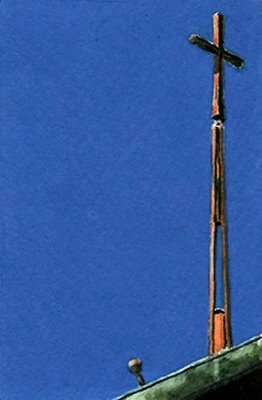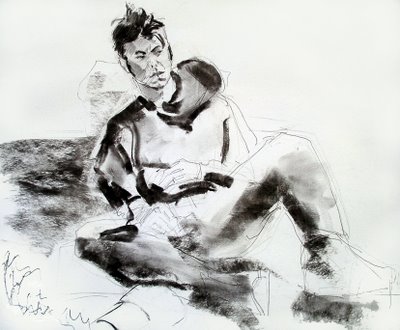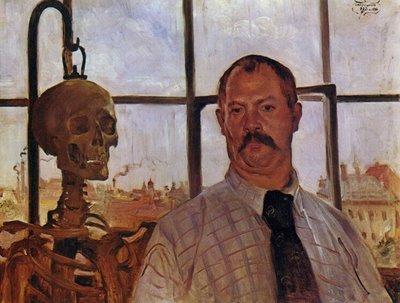Thursday, August 31, 2006
Tuesday, August 29, 2006
Monday, August 28, 2006
Saturday, August 26, 2006

Face
coloured pencil on paper
3.375" x 2.375" (8.7 x 11.3 cm)
July 2006. Johanna Toth.
This is another drawing by Winnipeg artist and illustrator Johanna Toth.
If Johanna had not given it to me, I suspect that she would have trashed this drawing. Johanna may not have thought much of it, but I quite love it for its simplicity and directness.
(It may be just me, but I find it almost impossible not to stare at the one completed eye when I'm looking at this drawing.)
Two other examples of Johanna Toth's work that have been posted are Woman with Umbrella and Untitled.
Friday, August 25, 2006
Wednesday, August 23, 2006
 Saint-Malo
Saint-Malo watercolour
8.7" x 11.3" (22.2 x 28.6 cm)
1890
James Wilson Morrice (1865-1924)
Musée des beaux-arts de Montréal
I wanted to get this watercolour posted before the end of summer.
There is an immediacy to this painting that I really like. You have that feeling of being with Morrice in Saint-Malo on a summer day in 1890.
(At the end of the nineteeth century Saint-Malo was apparently one of the most frequented French resorts.)
Tuesday, August 22, 2006
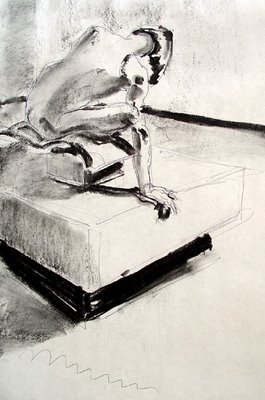
Man on a Box
graphite, ink, and charcoal
21" x 12" (53.5 x 30.5 cm)
This drawing has an abstract, almost impersonal quality to it. The figure seems to be just one of the elements in the drawing.
The model is the same friend who sat for the portrait posted on Sunday, August 20th.
It was an odd and difficult pose.
Sunday, August 20, 2006
Friday, August 18, 2006
Wednesday, August 16, 2006
Tuesday, August 15, 2006
Monday, August 14, 2006
Saturday, August 12, 2006
Thursday, August 10, 2006
Tuesday, August 08, 2006
Sunday, August 06, 2006
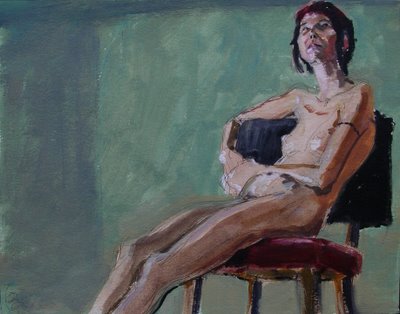 Model Looking Up
Model Looking Upoil
11" x 14" (27.9 x 35.6 cm)
This painting took about two hours to complete.
The viewpoint is lower than the chair. The model and the chair were on a stage.The model for this drawing is the same as for B., posted Sunday, July 9th.
Friday, August 04, 2006
Corinth suffered some paralysis as a result of the stroke, and he may have had to switch hands to paint. No doubt this accounts for some of the change in his work, but maybe not all.
Thursday, August 03, 2006

Woman Leaning on a Box
ink, oil pastel, charcoal, and conté
8.9" x 7.9" (22.5 x 20.2 cm)
This drawing was originally finished in oil pastel; however, it was not until most of the oil pastel was removed that the drawing seem to take on any interest.
Some final touches were added wih charcoal and white conté.
Tuesday, August 01, 2006
 Walchensee, Silverway 1923
Walchensee, Silverway 1923oil on canvas
23.75" x 35.125" (60.3 x 89.2 cm)
1923. Lovis Corinth (1858-1925). Saint Louis Art Musuem.
Lovis Corinth was one of the artists I had in mind when I mentioned in Saturday, July 29th's post that Resevoir, New Mexico owed more to expressionist and abstract art than to the actual scene.
Here is a brief biography of Corinth taken from Wikipedia:
Corinth was born in Tapiau, East Prussia. He studied in Paris and Munich, joined the Berlin Secession group, and later succeeded Max Liebermann as president. His early work was naturalistic in approach. Corinth was antagonistic toward the expressionist movement, although after a stroke in 1911 his style loosened and took on many expressionistic qualities. His colors became more vibrant, and he created portraits and landscapes of extraordinary vitality and power.
Corinth showed an early talent for drawing and attended the Munich Academy in 1880, which rivaled Paris as the avant-garde art center in Europe at the time. He later traveled to Paris where he studied under William-Adolphe Bouguereau at the Acadèmie Julian. In 1891, Corinth returned to Munich, but in 1892 he abandoned the Munich Academy and joined the very first Secession. In 1894, he joined the Free Association, and in 1899 he exhibited in an exhibition organized by the Berlin Secession. These nine Munich years were not his most productive and he was perhaps better known for his ability to drink large amounts of red wine and champagne.
In 1900 he moved to Berlin where he had a one-man exhibition at a famous gallery owned by Paul Cassirer. In 1902 at the age of 43, he opened a School of Painting for Women and married his first student, Charlotte Berend, some 20 years his junior. Charlotte was his youthful muse, his spiritual partner, and the mother of his two children. She had a profound influence on him and family life became a major theme in his art during this time.
In 1911, he suffered a stroke and was partially paralyzed on his left side. With the help of his wife, a year later he was back to work with his right hand. It was during this time that landscapes became a significant part of his oeuvre. From 1915-1925, he was elected President of the Berlin Secession. In 1925, he traveled to the Netherlands to look at his favorite Dutch masters, where he caught pneumonia and died in Zandvoort.
Corinth was quite prolific and in the last fifteen years of his life, he produced more than 900 graphic works including 60 self-portraits. The landscapes he created between 1919 and 1925 are perhaps the most desirable images of his entire oeuvre.
One of Corinth's nudes is posted below.

